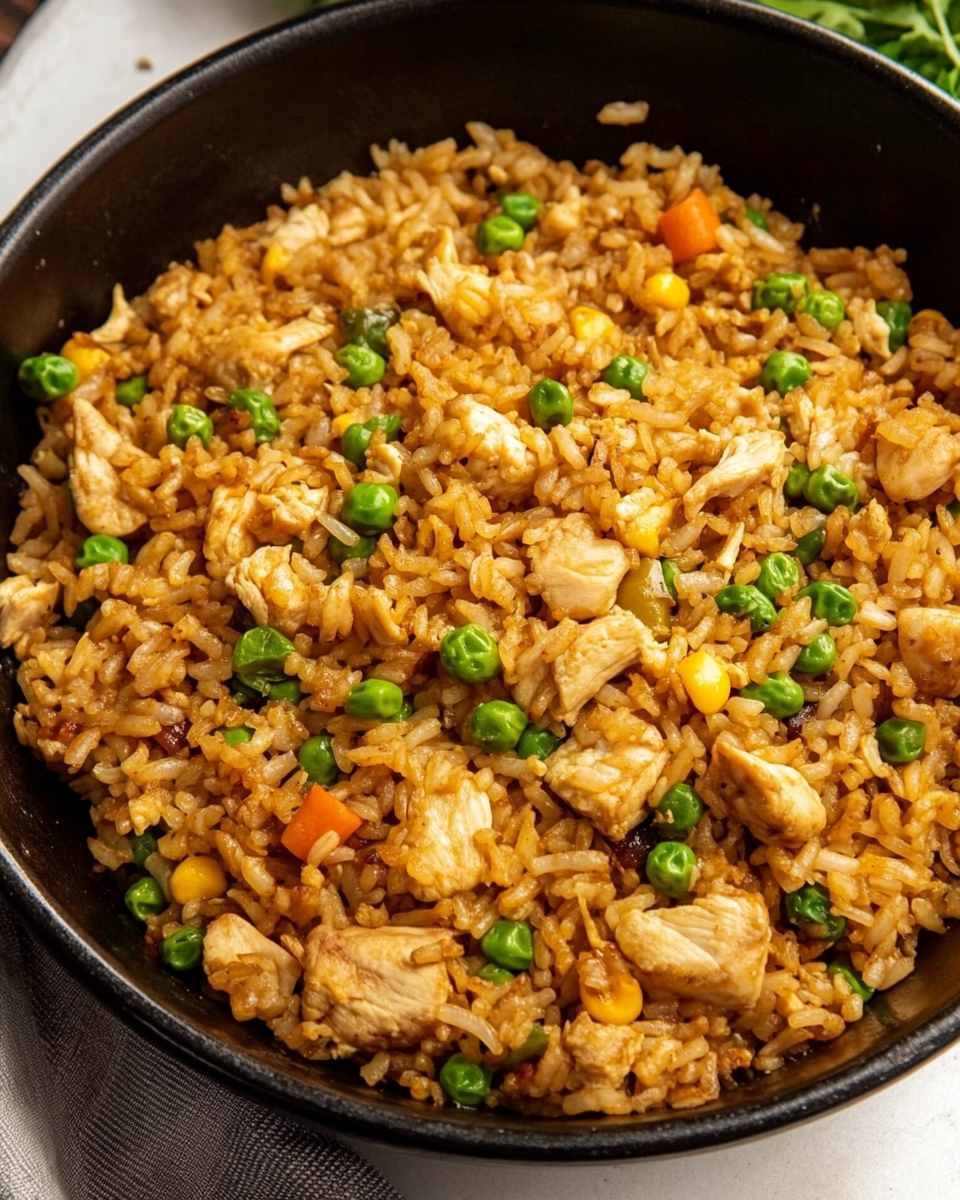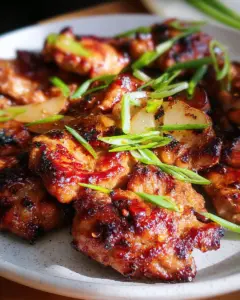There’s a reason chicken fried rice is a staple on takeout menus everywhere – it’s the perfect balance of savory, satisfying, and simple. This restaurant-style version brings all the authentic flavors of hibachi cooking right to your home kitchen. With tender pieces of chicken, colorful vegetables, and fluffy grains of rice all coated in a rich, umami-packed sauce, this dish delivers everything you love about the takeout classic but with fresher ingredients and better flavor control.

What sets this recipe apart is its attention to the small details that make restaurant fried rice so good. The chicken gets a quick marinade in sesame oil and soy sauce for depth of flavor. Day-old rice ensures the perfect dry texture that fries up beautifully. A combination of butter and oil gives that signature richness, while scrambled eggs add protein and texture. Best of all, it comes together in about 30 minutes, making it ideal for busy weeknights when you’re craving something delicious but don’t want to spend hours cooking.
Essential Tools and Equipment
Having the right tools makes preparing fried rice much easier. Here’s what you’ll need:
- Large skillet or wok – The wide surface area and high sides are perfect for stir-frying. A well-seasoned cast iron or carbon steel wok works best, but any large frying pan will do.
- Wooden or bamboo spatula – Gentle on cookware surfaces and ideal for folding ingredients without breaking the rice.
- Sharp chef’s knife – For cleanly dicing the chicken and vegetables into uniform pieces.
- Cutting board – Preferably one with a groove to catch juices.
- Measuring spoons and cups – For accurately portioning ingredients.
- Mixing bowls – To hold prepped ingredients before cooking.
Each tool serves an important purpose. The wok’s shape allows for quick evaporation of moisture, preventing soggy rice. A sharp knife ensures even cooking times for all ingredients. Measuring tools help maintain the perfect balance of flavors that makes this dish so crave-worthy.
Preparation Tips for Perfect Results
Proper preparation is the secret to restaurant-quality fried rice at home. Follow these tips:
- Use day-old rice – Freshly cooked rice contains too much moisture. Refrigerated rice dries out slightly, creating the ideal texture. Spread it on a baking sheet to cool completely if using freshly made.
- Cut ingredients uniformly – Dice the chicken and vegetables into similar-sized pieces for even cooking. About ½-inch pieces work well.
- Prep everything beforehand – Fried rice cooks quickly, so have all ingredients measured, chopped, and within reach.
- Pat chicken dry – Remove excess moisture from the chicken pieces with paper towels to ensure proper browning.
- Thaw frozen vegetables – Let them sit at room temperature for 10-15 minutes to prevent excess water in the dish.
Ingredients List
For the Chicken:
- 1 ½ teaspoons sesame oil
- 1 tablespoon neutral oil (avocado or canola work well)
- ¾ pound chicken breasts, cut into small pieces
- 2 tablespoons low-sodium soy sauce
- 1 tablespoon butter
- 2 teaspoons fresh lemon juice
- Salt to taste
- Pepper to taste
For the Fried Rice:
- 1 teaspoon neutral oil
- ½ cup diced white onion
- 1 cup frozen mixed vegetables (peas and carrots)
- 2 large eggs
- 4 cups cooked rice, cooled
- 3 tablespoons butter
- 3 tablespoons low-sodium soy sauce
- Sesame seeds for garnish (optional)
Step-by-Step Cooking Instructions
Cook the Chicken:
- Heat the sesame oil and neutral oil in a large skillet or wok over medium-high heat.
- Once the oil shimmers, add the chicken pieces in a single layer. Let cook undisturbed for 1 minute to develop color.
- Add the soy sauce, butter, lemon juice, salt, and pepper. Continue cooking, stirring occasionally, until the chicken is cooked through (about 1-3 more minutes).
- Transfer the chicken to a clean bowl and set aside. Wipe out the skillet with a paper towel.
Make the Fried Rice:
- Heat the neutral oil in the same skillet over medium-high heat.
- Add the diced onion and frozen vegetables. Cook, stirring frequently, until the onions turn translucent (about 3 minutes).
- Push the vegetables to one side of the pan. Crack the eggs into the empty space and scramble until fully set.
- Add the cooked rice and butter. Stir frequently, breaking up any clumps, for about 5 minutes.
- Pour in the soy sauce and continue cooking for another minute.
- Return the cooked chicken to the skillet. Stir everything together until well combined and heated through.
- Taste and adjust seasoning with additional salt or pepper if needed.
Chef’s Tips:
- For extra flavor, add a teaspoon of grated ginger or minced garlic with the vegetables.
- If the rice sticks to the pan, add a small amount of oil around the edges.
- Let the rice sit undisturbed for short periods to develop crispy bits, a hallmark of great fried rice.
Presentation matters when recreating the restaurant experience at home. Serve your chicken fried rice in wide, shallow bowls to showcase the colorful ingredients. For an authentic touch, provide chopsticks alongside a fork for those less comfortable with them. A small dish of chili oil or sriracha on the side allows guests to adjust the heat level to their preference.
Portion size is important – this recipe makes about six servings as a main course. For a heartier meal, increase the chicken quantity by half. If serving as part of a multi-course Asian-inspired dinner, reduce portions to about ¾ cup per person. Garnish with a sprinkle of toasted sesame seeds and thinly sliced green onions for visual appeal and added texture.
Timing is key for the best eating experience. Fried rice is at its peak when served immediately after cooking, while the rice still has that perfect balance of tenderness and slight chewiness. The heat from the freshly cooked dish will keep it warm at the table for several minutes without compromising texture.
Common Mistakes and How to Avoid Them
Even experienced cooks can encounter issues when making fried rice. Here are the most frequent problems and their solutions:
Soggy or Mushy Rice
The primary culprit is usually using freshly cooked rice that hasn’t had time to dry. Rice straight from the cooker contains too much moisture. Always use cooled, day-old rice or spread freshly cooked rice on a baking sheet to dry for at least 30 minutes before frying.
Lack of Flavor Depth
Many home cooks rely solely on soy sauce for seasoning. For more complex flavor, consider adding a teaspoon of oyster sauce or fish sauce along with the soy sauce. The butter called for in this recipe also contributes richness that mimics restaurant versions.
Overcrowded Pan
Trying to cook too much at once leads to steaming rather than frying. If doubling the recipe, cook in batches or use an exceptionally large wok. The ingredients should have room to move freely in the pan for proper caramelization.
Incorrect Heat Level
Medium-high heat is essential for proper fried rice. Too low, and the ingredients will stew rather than fry. Too high, and you risk burning. Watch for the oil shimmering but not smoking before adding ingredients.
Unevenly Cooked Ingredients
Cut all components to similar sizes for consistent cooking. The chicken pieces should be bite-sized (about ½-inch), and vegetables diced proportionally. Frozen vegetables should be thawed to prevent cold spots in the dish.
Perfecting Your Technique
To elevate your chicken fried rice from good to exceptional, implement these professional tips:
- Press the rice against the hot surface of the pan for brief periods to create those prized crispy bits that add textural contrast.
- Toss, don’t stir – use a flipping motion with your spatula to combine ingredients without breaking the rice grains.
- Season in layers – add a pinch of salt when cooking the chicken, another with the vegetables, and final adjustment at the end.
- Control moisture – if the mixture seems wet while cooking, increase the heat slightly and stir more frequently to evaporate excess liquid.
- Rest the dish for two minutes after cooking to allow flavors to meld before serving.
Side Dish Recommendations
A well-chosen side can complement and enhance your chicken fried rice. Here are eight excellent pairings:
Egg Drop Soup
This light, silky soup makes an ideal starter. Its mild flavor won’t compete with the bold tastes of the fried rice.
Steamed Edamame
Sprinkled with coarse sea salt, these young soybeans provide a protein-rich, slightly crunchy contrast.
Asian Cucumber Salad
Thinly sliced cucumbers tossed with rice vinegar, sesame oil, and red pepper flakes offer a refreshing, palate-cleansing bite.
Vegetable Spring Rolls
Crispy wrappers filled with shredded vegetables add textural variety and work well for dipping in sweet chili sauce.
Miso Glazed Eggplant
Roasted eggplant with a sweet-savory miso glaze contributes umami depth and makes a satisfying vegetarian option.
Spicy Kimchi
The fermented cabbage’s pungent, spicy notes cut through the richness of the fried rice beautifully.
Seaweed Salad
This nutrient-dense side brings oceanic flavors and an appealing chewy texture to the meal.
Teriyaki Grilled Pineapple
Caramelized pineapple slices brushed with teriyaki sauce provide a sweet counterpoint to the savory main dish.
When planning your menu, select sides that offer contrasting textures and flavors to create a balanced meal. Two to three side dishes are usually sufficient for a complete dining experience. Consider your guests’ preferences – those who enjoy spicy foods might appreciate kimchi, while others may prefer the mildness of steamed edamame.Presentation matters when recreating the restaurant experience at home. Serve your chicken fried rice in wide, shallow bowls to showcase the colorful ingredients. For an authentic touch, provide chopsticks alongside a fork for those less comfortable with them. A small dish of chili oil or sriracha on the side allows guests to adjust the heat level to their preference.
Portion size is important – this recipe makes about six servings as a main course. For a heartier meal, increase the chicken quantity by half. If serving as part of a multi-course Asian-inspired dinner, reduce portions to about ¾ cup per person. Garnish with a sprinkle of toasted sesame seeds and thinly sliced green onions for visual appeal and added texture.
Timing is key for the best eating experience. Fried rice is at its peak when served immediately after cooking, while the rice still has that perfect balance of tenderness and slight chewiness. The heat from the freshly cooked dish will keep it warm at the table for several minutes without compromising texture.
Common Mistakes and How to Avoid Them
Even experienced cooks can encounter issues when making fried rice. Here are the most frequent problems and their solutions:
Soggy or Mushy Rice
The primary culprit is usually using freshly cooked rice that hasn’t had time to dry. Rice straight from the cooker contains too much moisture. Always use cooled, day-old rice or spread freshly cooked rice on a baking sheet to dry for at least 30 minutes before frying.
Lack of Flavor Depth
Many home cooks rely solely on soy sauce for seasoning. For more complex flavor, consider adding a teaspoon of oyster sauce or fish sauce along with the soy sauce. The butter called for in this recipe also contributes richness that mimics restaurant versions.
Overcrowded Pan
Trying to cook too much at once leads to steaming rather than frying. If doubling the recipe, cook in batches or use an exceptionally large wok. The ingredients should have room to move freely in the pan for proper caramelization.
Incorrect Heat Level
Medium-high heat is essential for proper fried rice. Too low, and the ingredients will stew rather than fry. Too high, and you risk burning. Watch for the oil shimmering but not smoking before adding ingredients.
Unevenly Cooked Ingredients
Cut all components to similar sizes for consistent cooking. The chicken pieces should be bite-sized (about ½-inch), and vegetables diced proportionally. Frozen vegetables should be thawed to prevent cold spots in the dish.
Perfecting Your Technique
To elevate your chicken fried rice from good to exceptional, implement these professional tips:
- Press the rice against the hot surface of the pan for brief periods to create those prized crispy bits that add textural contrast.
- Toss, don’t stir – use a flipping motion with your spatula to combine ingredients without breaking the rice grains.
- Season in layers – add a pinch of salt when cooking the chicken, another with the vegetables, and final adjustment at the end.
- Control moisture – if the mixture seems wet while cooking, increase the heat slightly and stir more frequently to evaporate excess liquid.
- Rest the dish for two minutes after cooking to allow flavors to meld before serving.
Side Dish Recommendations
A well-chosen side can complement and enhance your chicken fried rice. Here are eight excellent pairings:
Egg Drop Soup
This light, silky soup makes an ideal starter. Its mild flavor won’t compete with the bold tastes of the fried rice.
Steamed Edamame
Sprinkled with coarse sea salt, these young soybeans provide a protein-rich, slightly crunchy contrast.
Asian Cucumber Salad
Thinly sliced cucumbers tossed with rice vinegar, sesame oil, and red pepper flakes offer a refreshing, palate-cleansing bite.
Vegetable Spring Rolls
Crispy wrappers filled with shredded vegetables add textural variety and work well for dipping in sweet chili sauce.
Miso Glazed Eggplant
Roasted eggplant with a sweet-savory miso glaze contributes umami depth and makes a satisfying vegetarian option.
Spicy Kimchi
The fermented cabbage’s pungent, spicy notes cut through the richness of the fried rice beautifully.
Seaweed Salad
This nutrient-dense side brings oceanic flavors and an appealing chewy texture to the meal.
Teriyaki Grilled Pineapple
Caramelized pineapple slices brushed with teriyaki sauce provide a sweet counterpoint to the savory main dish.
When planning your menu, select sides that offer contrasting textures and flavors to create a balanced meal. Two to three side dishes are usually sufficient for a complete dining experience. Consider your guests’ preferences – those who enjoy spicy foods might appreciate kimchi, while others may prefer the mildness of steamed edamame.
To ensure your restaurant-style chicken fried rice turns out perfectly every time, keep these professional techniques in mind:
- Use High Heat – A hot skillet or wok is essential for achieving that signature smoky, slightly charred flavor. If your stove doesn’t get hot enough, let the pan preheat for an extra minute before adding ingredients.
- Don’t Over-Stir – Constant stirring prevents proper browning. Let the rice sit for 20-30 seconds between stirs to develop crispy bits.
- Butter is Key – Many home cooks skip butter, but it adds richness and depth that oil alone can’t replicate. The combination of butter and oil mimics authentic hibachi flavor.
- Adjust Seasoning at the End – Soy sauce can vary in saltiness, so taste before adding extra salt. A splash of rice vinegar or lime juice at the end brightens the dish.
- Double the Recipe with Caution – If making a larger batch, cook in two separate portions to avoid overcrowding the pan, which leads to steaming instead of frying.
Vegetarian & Dietary Variations
- Vegetarian Option – Replace chicken with tofu, tempeh, or extra eggs. Press tofu before cooking to remove excess moisture.
- Gluten-Free – Use tamari or coconut aminos instead of soy sauce.
- Low-Carb Alternative – Substitute cauliflower rice, but cook it separately to remove excess moisture before frying.
Storage and Reheating Instructions
Refrigerating Leftovers
- Let the fried rice cool completely before storing.
- Transfer to an airtight container and refrigerate for up to 3 days.
- Avoid leaving at room temperature for more than 2 hours to prevent bacterial growth.
Freezing for Later Use
- Fried rice freezes well if stored properly.
- Portion into freezer-safe bags or containers, removing as much air as possible.
- Label with the date and use within 1 month for best quality.
Best Reheating Methods
- Stovetop (Recommended) – Heat a small amount of oil in a pan, add the rice, and stir-fry until hot. Sprinkle a few drops of water to prevent drying out.
- Microwave – Place in a microwave-safe dish, cover with a damp paper towel, and heat in 30-second intervals, stirring between each.
- Avoid reheating multiple times – This can make the rice dry or rubbery.
Frequently Asked Questions (FAQs)
Can I use freshly cooked rice?
While possible, day-old rice works best because it’s drier and less sticky. If using fresh rice, spread it on a tray and let it cool completely before frying.
Why is my fried rice soggy?
This usually happens from:
- Using warm, freshly cooked rice
- Overloading the pan (which steams instead of fries)
- Not cooking on high enough heat
Can I use brown rice?
Yes, but brown rice retains more moisture. Spread it out to dry before frying, and expect a slightly chewier texture.
What’s the best oil for fried rice?
A neutral oil with a high smoke point (like avocado or canola) is best for frying. Sesame oil is used for flavor but shouldn’t be the primary cooking oil.
How do I make it taste more like restaurant fried rice?
- Use butter for richness
- Let the rice sit briefly in the pan for crispy bits
- Add a splash of oyster sauce or fish sauce for umami depth
Can I add other vegetables?
Absolutely! Bell peppers, mushrooms, and bean sprouts work well. Just ensure they’re diced small and cooked until tender.
Conclusion
Mastering restaurant-style chicken fried rice at home is easier than you think—once you know the key techniques. From using day-old rice to achieving the perfect balance of buttery richness and savory soy sauce, every step contributes to that authentic takeout flavor.
This versatile dish adapts to dietary preferences, works great for meal prep, and reheats beautifully. Whether you’re cooking for a quick weeknight dinner or recreating a hibachi experience at home, this recipe delivers better-than-takeout results every time.
Now that you have all the tips, tricks, and troubleshooting advice, it’s time to fire up the stove and make your best batch yet. Happy cooking!
Restaurant-Style Chicken Fried Rice
Ingredients
For the Chicken:
- 1 ½ teaspoons sesame oil
- 1 tablespoon neutral oil such as avocado or canola oil
- ¾ pound chicken breasts cut into very small pieces
- 2 tablespoons low-sodium soy sauce
- 1 tablespoon butter
- 2 teaspoons fresh lemon juice
- Salt to taste
- Pepper to taste
For the Fried Rice:
- 1 teaspoon neutral oil
- ½ cup diced white onion
- 1 cup frozen mixed vegetables peas and carrots
- 2 large eggs
- 4 cups cooked rice cooled to room temperature (see Notes)
- 3 tablespoons butter
- 3 tablespoons low-sodium soy sauce
- Sesame seeds optional, for garnish
Instructions
For the Chicken:
- Heat the sesame oil and neutral oil in a large skillet or wok over medium-high heat.
- Once hot, add the chicken pieces and cook for 1 minute without stirring.
- Add the soy sauce, butter, lemon juice, salt, and pepper. Cook until the chicken is no longer pink (about 1–3 minutes), stirring minimally to allow it to brown nicely.
- Transfer the cooked chicken to a bowl and set aside. Wipe out the skillet or wok to use again.
For the Fried Rice:
- Heat the neutral oil in the same skillet over medium-high heat. Add the diced onion and frozen mixed vegetables. Sauté for about 3 minutes, until the onions become translucent.
- Push the vegetables to one side of the skillet. Crack the eggs into the empty space and scramble them with a spatula until fully cooked.
- Add the cooked rice and butter to the skillet. Stir frequently and cook for 5 minutes.
- Stir in the soy sauce and cook for another minute.
- Return the cooked chicken to the skillet. Season with salt and pepper, then stir everything together until well combined and heated through.
- Serve warm, garnished with sesame seeds if desired.
- Notes
- Chicken: For a higher-protein dish, double the amount of chicken.
- Rice: Leftover rice or cooled rice works best, as fresh rice tends to be too moist and clumpy. Microwaveable ready rice is a convenient option.
- Seasoning: Don’t rely solely on soy sauce for flavor—use salt and pepper to balance the seasoning and prevent overly salty or soggy rice.






